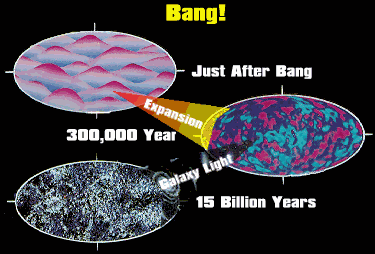 The beginning: Our understanding of the evolution of the universe is one of the great achievements of 20th-century science. This knowledge comes from decades of innovative experiments and theories. Our best efforts to explain this wealth of data are embodied in a theory known as the standard cosmological model or the big bang cosmology. The major claim of the theory is that the universe is expanding in a nearly homogeneous way from a dense early state. At present, there are no fundamental challenges to the big bang theory, although there are certainly unresolved issues; the predictions of the theory have survived all tests to date. Yet the big bang model goes only so far, and many fundamental mysteries remain. What was the universe like before it was expanding? What will happen in the distant future, when the last of the stars exhaust the supply of nuclear fuel? No one knows the answers to such questions yet.
The beginning: Our understanding of the evolution of the universe is one of the great achievements of 20th-century science. This knowledge comes from decades of innovative experiments and theories. Our best efforts to explain this wealth of data are embodied in a theory known as the standard cosmological model or the big bang cosmology. The major claim of the theory is that the universe is expanding in a nearly homogeneous way from a dense early state. At present, there are no fundamental challenges to the big bang theory, although there are certainly unresolved issues; the predictions of the theory have survived all tests to date. Yet the big bang model goes only so far, and many fundamental mysteries remain. What was the universe like before it was expanding? What will happen in the distant future, when the last of the stars exhaust the supply of nuclear fuel? No one knows the answers to such questions yet.
Redshift: An apparent shift toward longer wavelengths of spectral lines in the radiation emitted by an object caused by the emitting object moving away from the observer. Also, part of the doppler effect.
Doppler Effect: The apparent change in wavelength of sound or light caused by the motion of the source, observer or both. Waves emitted by a moving object as received by an observer will be blueshifted (compressed) if approaching, redshifted (elongated) if receding. It occurs both in sound and light. How much the frequency changes depends on how fast the object is moving toward or away from the receiver.
Cosmological Redshift: An effect where light emitted from a distant source appears redshifted because of the expansion of spacetime itself.
AU: An AU (astronomical unit) is the measure of the distance between the earth and the sun. It is used for calculating distances around this and other solar systems.

 The beginning: Our understanding of the evolution of the universe is one of the great achievements of 20th-century science. This knowledge comes from decades of innovative experiments and theories. Our best efforts to explain this wealth of data are embodied in a theory known as the standard cosmological model or the big bang cosmology. The major claim of the theory is that the universe is expanding in a nearly homogeneous way from a dense early state. At present, there are no fundamental challenges to the big bang theory, although there are certainly unresolved issues; the predictions of the theory have survived all tests to date. Yet the big bang model goes only so far, and many fundamental mysteries remain. What was the universe like before it was expanding? What will happen in the distant future, when the last of the stars exhaust the supply of nuclear fuel? No one knows the answers to such questions yet.
The beginning: Our understanding of the evolution of the universe is one of the great achievements of 20th-century science. This knowledge comes from decades of innovative experiments and theories. Our best efforts to explain this wealth of data are embodied in a theory known as the standard cosmological model or the big bang cosmology. The major claim of the theory is that the universe is expanding in a nearly homogeneous way from a dense early state. At present, there are no fundamental challenges to the big bang theory, although there are certainly unresolved issues; the predictions of the theory have survived all tests to date. Yet the big bang model goes only so far, and many fundamental mysteries remain. What was the universe like before it was expanding? What will happen in the distant future, when the last of the stars exhaust the supply of nuclear fuel? No one knows the answers to such questions yet.
